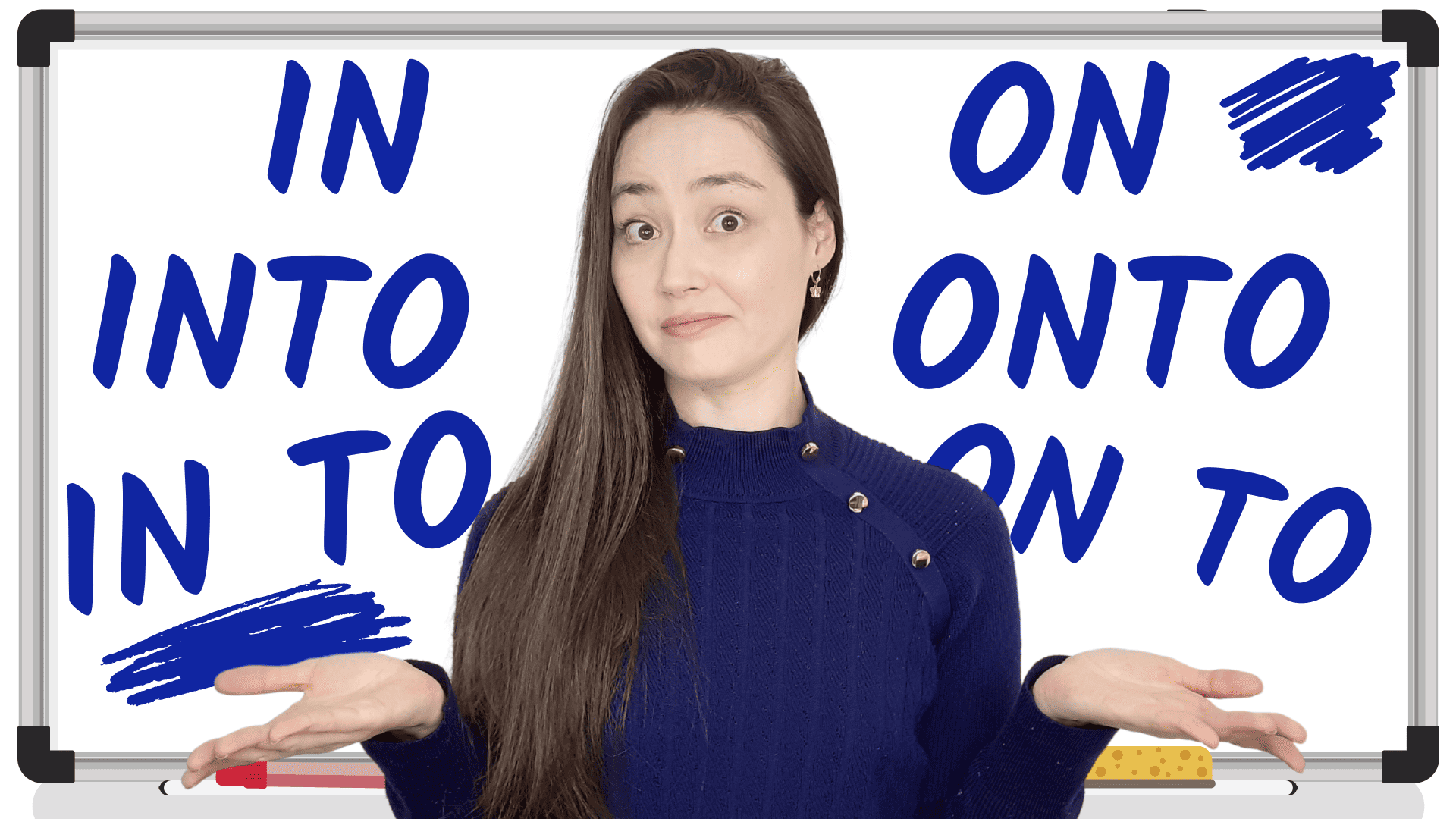In vs. Into vs. In to vs. On vs. Onto vs. On to
You can watch my YouTube lesson OR keep scrolling to read more.
IN and ON = the location of an object or action
IN: The cat is in the box.
Where is the cat? In the box.
ON: The cat is on the box.
Where is the cat? On the box.
IN: This picture was taken in Spain.
Where was the picture taken? In Spain.
ON: I stepped on a jellyfish.
Where did I step? ON a jellyfish.
INTO and ONTO = a change of the location
INTO: The cat walked into the box.
ONTO: The cat jumped onto the box.
INTO: I moved the TV into my bedroom.
ONTO: She carefully placed the flowers onto the coffin.
Think about this like “GO TO”:
I am going to school.
We went to the beach.
Just like INTO and ONTO, “TO” shows us the destination.
Let’s compare:
He backflipped in the water.
He was already in the water when he did this.
He backflipped into the water.
He changed his location. He was on the cliff before he went into the water.
We walked on the boat.
This is where we walked.
We walked onto the boat.
We changed our location. First we were on the dock before walking onto the boat.
INTO can also be used for a transformation:
A caterpillar turns into a butterfly.
There is a clear transformation.
I had to translate all of these documents into English.
The language was changed.
INTO can also be used for an impact.
A bird flew into my window.
Cars are crashed into a wall to test their safety.
In both of these sentences we are talking about an impact, not moving inside a place.
IN AND ON don’t always need an object.
*Many times the object is optional.
INTO and ONTO always need an object.
✅Come into my office.
✅Come in.
✅He walked onto the stage without his microphone.
✅He walked on without his microphone.
If the destination is obvious, you can often omit the “TO” plus the destination.
dive, drop, fall, jump, put, throw
With these verbs, both in and into / on and onto can be used interchangeably.
✅ I put the ice cream in the freezer.
✅I put the ice cream into the freezer.
✅He came home and threw his backpack on the bed.
✅He came home and threw his backpack onto the bed.
Mini Review
IN and ON show the location of an action or object
The laundry is in the basket.
The basket is on the washing machine.
INTO / ONTO = show a change or transformation
We decided to move the washing machine into the kitchen.
First we had to lift it onto a dolly before we could move it.
INTO can also show an impact
A bird flew into the window.
INTO and ONTO always need an object
It started to rain, so I brought the laundry into the house.
If the object is already clear we often just use IN or ON.
It started to rain, so I brought the laundry in.
Some verbs can be used with these prepositions interchangeably
Put the dirty laundry in/into the washing machine.
We have these rules, but it’s important to remember that sometimes native speakers use these prepositions interchangeably when it’s obvious what is being said:
Look in my eyes and tell me the truth.
Look into my eyes and tell me the truth.
IN TO or ON TO?
Whether to use INTO / IN TO or ONTO / ON TO can be a bit confusing. This is mainly because in spoken English these sound the same. The difference between a space and no space is only important in written English.
We all chipped in to buy Frankie a present.
Try the dress on to see if it fits you.
Chip in is a phrasal verb.
Try on is a phrasal verb.
To buy is an infinitive.
To see is an infinitive.
Do these need to be connected?
No. The phrasal verb and infinitive are separate parts. It’s just happens that in/on and to are next to each other in a sentence. Let’s look at another example:
We went out to celebrate my birthday.
Go out is a phrasal verb.
To celebrate is an infinitive.
You wouldn’t you write: We went outto celebrate my birthday.
There are so many phrasal verbs in English! You can watch my video lesson on 100 phrasal verbs here:
Or read about how to learn phrasal verbs easily here:
10 TIPS TO LEARN PHRASAL VERBS EASILY
TO isn’t only part of the infinitive. TO can also be a preposition.
The student handed his essay in to the teacher.
“Hand in” is a phrasal verb. “To” is the preposition.
Take a booklet and pass the stack on to the person next to you.
“Pass on” is a phrasal verb. “To” is the preposition.
The mayor decided not to give in to the protesters’ demands.
“Give in” is a phrasal verb. “To” is the preposition.
Again, TO/IN are next to TO, but they don’t need to be connected.
However, it’s important to note that some phrasal verbs already have INTO and ONTO as their particle:
Settle into
Eat into
Grow into
Talk into
Come onto
Latch onto
Hang onto
Get onto
Move onto
Common Question
Which sentence is correct?
Please log in to your student account.
Please log into your student account.
The first one is correct. We have our phrasal verb “log in” and the preposition “to”.
✅Please log in to your student account.
Please log into your student account.
But, “log into” is very common and you will see this in emails and on websites. Many people do not consider this a mistake.
Test






